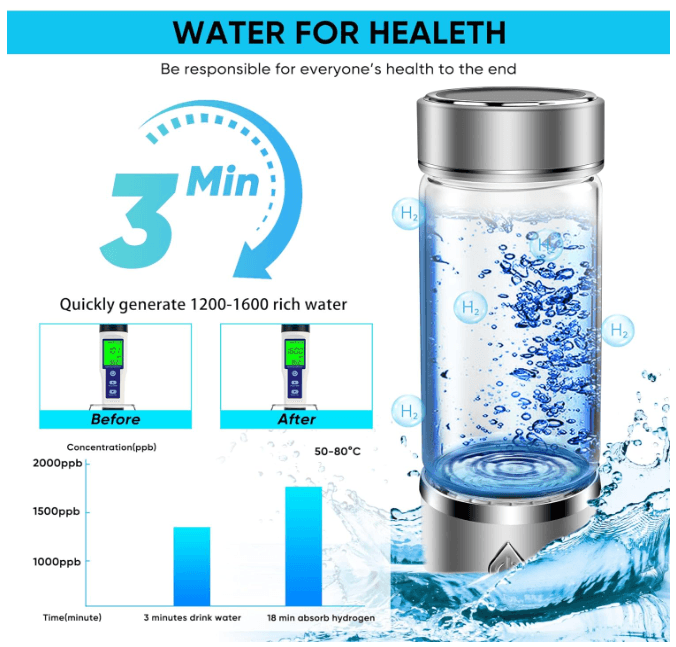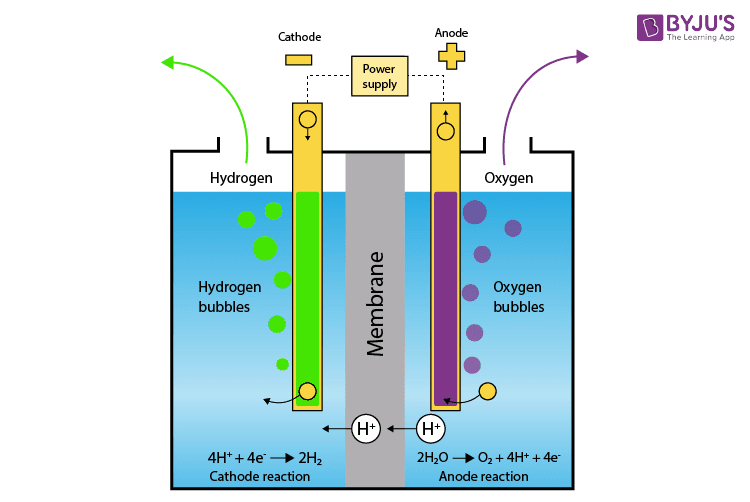- Published on
Hydrogen Generation At Home
- Authors

- Name
- Robert Claus
A "New" Product
A family member recently showed me that you can now buy a "hydrogen generator" on Amazon for about $50. These devices look like a water bottle that you plug into a wall. They have a small base, but not much else to them. However, they claim to generate hydrogen gas using electricity.

The idea is that a little bit of hydrogen gas in your drinking water can have health benefits. This has been a common pseudo-scientific idea in some parts of the world for decades, so while it was new for me, it didn't seem that radical in general. The far more interesting part for me was that they were generating hydrogen gas directly in the house with "new technology".
Needless to say, I did a bit of research and found that this "new technology" was exactly what you would expect if you've worked in a chemistry research lab in the last 50 years.
Theoretical Electrolysis
Electrolysis is the process by which water molecules are split into Hydrogen and Oxygen gas using electricity. However, this reaction is not as simple as injecting energy into two water molecule to split them into 3 gas molecules. When you run it, you see that Hydrogen gas always forms at the cathode, while the Oxygen gas forms at the anode.

A useful frame of reference for understanding this better is that water is naturally willing to break up into Hydroxide (OH-) and Hydrogen (H+) ions. This is what gives water a natural pH of 7 - the equilibrium concentration of these ions. Given enough of an electric field at the Cathode, the OH- ion will further split off it's remaining hydrogen atom as well. This leaves an Oxygen ion with a -2 charge. Two of these Oxygen ions can bond by giving up electrons to the Cathode - producing Oxygen gas and leaving the H+ ions in solution.
The H+ ions each have a charge, which attracts them to the negative Anode (and corresponding high electron concentration). Here the H+ ions can combine into Hydrogen gas using those electrons. Hence we end up with Oxygen gas at the Cathode and Hydrogen gas at the Anode - making it easy to collect the two separately.
Practically, this process can be set up with a simple tank of water and physical space between the Anode and Cathode. However, there are efficiency gains if you add a plastic insulating membrane to separate the Anode and Cathode. This membrane is designed to insulate the two sides electrically while allowing H+ ions to travel through. It also has the advantage of separating the gases physically so that there is less mixing of diffused Hydrogen and Oxygen gas.
Practical Electrolysis Problems
While Electrolysis has been around for a long time, there are some practical issues with just sticking an extension cord into a glass of water to generate Hydrogen and Oxygen gas. These raise some natural questions about how these products work.
Power Type
One obvious issue with generating hydrogen at home is that our high power wall outlets use alternating current. This means the Anode and Cathode switch very frequently, and you will end up with a mix of Oxygen and Hydrogen gas at both sides. This isn't a major issue since AC-to-DC converters are cheap to include in electronics now, but these are typically small battery chargers and hence imply a practical limit to how much hydrogen can be produced.
Power Amount
A very good membrane electrolysis process takes ~50kWh per kg of hydrogen. Hydrogen gas is not very soluble in water (~1.6mg per L), but a typical 5W phone charger would still take about two hour to fully saturate a cup of water. The 5 minutes these generators run would need to have fairly hefty AC-to-DC converters to actually reach the hydrogen levels they claim.
Flammability
A do-it-yourself hydrogen generator is naturally dangerous since hydrogen is highly flammable when mixed with a little bit of oxygen gas. This means any significant volume of Hydrogen should be handled very carefully - more so than a consumer product likely would bother. This again limits how much Hydrogen gas should be practically produced by these devices.
Minerals
When generating hydrogen at home, it is almost always using filtered drinking water. This means there are still minerals and impurities in the water; especially dissolved salts. These salts are often in a state of dissolved ions, and hence behave very similarly to the OH- and H+ ions during electrolysis. This can be dangerous since even common table salt (NaCl) will produce poisonous chlorine gas during the electrolysis process.
Technical Solutions
How do these drinking water hydrogen generators get past these limitations? They mostly don't. The volume of hydrogen produced is simply limited to a small amount. This manages the power and flammability issues. They do a good job spreading out the bubbles to make the small amount of gas "fill" the bottle while it's generating. Since the health benefits are somewhat homeopathic in nature - there is no clear hydrogen dosage recommended to see results - a lower volume doesn't really affect the efficacy of the product.
For the dangerous gases produced from minerals - none of the products I saw addressed the problem directly. The ones that even acknowledged it claimed that a feature of their product was to keep dangerous gases like Chlorine on the Oxygen side of the membrane and hence out of the drinking water. That does however mean they're leaking into the ambient room with the waste Oxygen. I don't think this is particularly dangerous to people given the production limits of the machines, but it's surprising that a machine that's likely producing Chlorine gas as a byproduct of typical operation is being sold as a health product.
Benefits?
As far as I could find in my research, the health benefits of hydrogen infused water are largely unproven. This seems to be from a combination of limited serious academic interest as well as the longitudinal nature of the claims. In what I could find, there seem to be some studies that support the claims and others that refute it. For example one study was worded in favor of the product, but all their data found no measurable evidence.
The theory (as I understand it) is that hydrogen gas is small enough to diffuse deeper into cell substructures than pretty much any other molecule. This allows it to react with reactive molecules (aka free radicals) trapped within the cell mitochondria that could otherwise cause damage to DNA or cell activity.
I have talked to some people that really like drinking the diffused hydrogen water - claiming that it helped with energy levels and generally feeling well. I even tried it myself and thought it tasted a bit "cleaner" than other water. However, scientifically I suspect these benefits had a lot to do with being mindful while drinking it, better hydration habits in general, and positive thinking.
My Thoughts On These Products
While I admit that the benefits could be true, it seems unlikely to have significant benefits for the average person. As discussed, the volume of hydrogen gas dissolved in the water is very low. If you drink it regularly, it might add up, but this seems to contradict the idea that it can permeate through (and hence out of) the body easily. Given the low volumes, the benefits seem largely homeopathic to me.
That being said, I don't think there's anything wrong with using this type of product if it makes you feel good. The literature does seem pretty clear on Hydrogen gas being harmless to ingest this way.